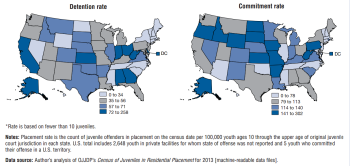New OJJDP Report Shows New Trends in Residential Placement of Juveniles

By Anne-Lise Vray, Juvenile Justice Fellow
A new report of the Office of Juvenile Justice and Delinquency Prevention analyzes the juvenile residential placement data for the year 2013, and finds that overall, more than 60,000 youth were in residential placement across the United States on October 23, 2013, a drop of over 12% compare to 2011 and of more than 44% since 2003.
While this report shows some encouraging trends, some others are worrisome. On the same date, 2,524 youth were locked up for status offenses, i.e. for misbehavior such as running away from home, skipping school, or speaking back to an adult – actions that are not considered crimes when committed by adults. Although the number of kids incarcerated for status offenses has decreased, it still represents almost 5% of all juveniles in residential placement, which is proportionally about the same as in 1997.
The report cautions that state variations in upper age of juvenile court jurisdiction influence placement rates. It points out that if all other factors were equal, one would expect higher juvenile placement rates in states where older youth are under juvenile court jurisdiction. Juvenile placement rates are also influenced by extended jurisdiction laws and transfer laws. States with laws allowing for youth to stay in juvenile facilities beyond the upper age of juvenile jurisdiction have higher placement rates than states with stricter laws, while states with broad transfer provisions would be expected to have lower juvenile placement rates than other states.
With those caveats in mind, the report highlights the geographic disparities in juvenile placement rates on the state level. The District of Columbia, South Dakota, and Wyoming have the highest juvenile placement rate per 100,000, while Vermont, Massachusetts and Hawaii have the lowest. Nationwide in 2013, 173 juvenile offenders were in placement for every 100,000 juveniles in the U.S. population.

